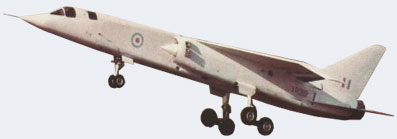BAC TSR-2
 The British Aircraft Corporation's TSR-2 was an ill-fated Cold War project in the early 1960s to create what would, at that time, have been one of the most advanced aircraft in the world.
The British Aircraft Corporation's TSR-2 was an ill-fated Cold War project in the early 1960s to create what would, at that time, have been one of the most advanced aircraft in the world.In the 1950s, the British Royal Air Force was aware that the Canberra bomber would need to be replaced, and a specification for its replacement with additional strike and reconnaissance roles was drafted in the form of GOR (General Operational Requirement) 339 in 1956. This specification was exceptionally ambitious for the technology of the day, requiring a supersonic all-weather aircraft that could deliver nuclear weapons over a long range, operate at high level (at Mach 2+) or low level (at Mach 1.2), with a short takeoff ability from rough and ready airstrips.
The envisioned "standard mission" for the TSR-2 was to carry a 2,000 lb (900 kg) weapon internally for a combat radius of 1,000 nautical miles (nm) (1,852 km). Of that mission 100 nm (185 km) was to be flown at higher altitudes at Mach 1.7 and the 200 nm (370 km) into and out of the target area was to be flown as low as 200 feet (60 m) at Mach 0.95. The rest of the mission was to be flown at Mach 0.92. If the entire mission were to be flown at the low 200-foot altitude, the mission radius was reduced to 700 nm (1300 km). Heavier weapons loads could be carried with further reductions in range.
The design was a large aircraft with large shoulder mounted slab-wing with down-turned tips, all-moving swept tailplane, a large all-moving fin. powered by two Bristol-Siddeley Olympus afterburning turbojets. The latter were a variant of those used in the Avro Vulcan and Concorde.
The design featured blown flaps to achieve the short take off and landing requirement, something which later designs would achieve with the technically more complex swing-wing approach. The aircraft featured some extremely sophisticated avionics for navigation and mission delivery which was also to be one of the reasons for the spiralling costs of the project. Some features, such as ground-following terrain radar, FLIR cameras, side-looking airborne radar and the sophisticated autopilot did only become commonplace on military aircraft later. The wing loading was high for its time, and this gave the aircraft the ability to fly at very high speed and low level with great stability without being constantly upset by thermals and other ground-related weather phenomena. This in turn made the innovative ground-following radar and autopilot system feasible.
Despite the rocketing costs, two prototype aircraft were completed. In testing the TSR-2 was found to easily meet the demanding performance specification. Aerodynamically the aircraft was trouble-free, but there were continual problems with the engines and the undercarriage. Initial flight tests were all performed with the undercarriage down and engine power strictly limited.The first supersonic test flight, the fourteenth overall, had to be performed with only one afterburner due to problems with one of the engines. A speed of Mach 1.2 was reached on that occasion.
The American team behind the General Dynamics F-111 project had been pressing their case and newspaper reports had suggested that the RAF were considering it. In the next year budget speech , the cancellation in favour of the F-111 was announced.
Instead of the TSR-2, the RAF decided it would buy the swing-wing American General Dynamics F-111 - however, the F-111 itself suffered such enormous cost escalation (exceeding that of the TSR-2 projection ) that the RAF eventually cancelled their order, procuring instead the F-4 Phantom II and the Blackburn Buccaneer.
Estimated Specifications
Dimensions:
Length: 89 ft ½ in (27.12 m)
Wingspan: 37 ft 1¾ in (11.27 m)
Height: 23 ft 9 in (7.24 m)
Wing area: 702.9 ft² (65.3 m²)
Weights:
Empty 54,750 lb (24,834 kg)
Loaded 79,573 lb lb (36,169 kg)
Maximum takeoff 102,200 lb (46,357 kg)
Powerplant:
Engines 2× Bristol-Siddeley Olympus B.O1.22R
Thrust 2× 30,610 lbf (2× 136.7 kN)
Maximum speed: Mach 2.15
Combat range: 1150 miles (1850 km)
Ferry range: 4256 miles (6850 km)
Service ceiling: 54,000 ft (16,459 m)
Rate of climb: 50,000 ft/min (16,000 m/min)
Armament:
Payload Internal weapons bay, 20 ft (6 m) with 1 nuclear or 6 x 1000 lb (450 kg) HE, or 4 x 37 rocket packs or nuclears on inner pylons only.
Links:
www.thunder-and-lightnings.co.uk
www.historyofwar.org
www.unrealaircraft.com
(Adapted from http://www.wikipedia.org/ )
Labels: aircraft, aviation, Avro Vulcan, blown flaps, Bristol-Siddeley Olympus, British Aircraft Corporation, Canberra, Concorde, dreamhost promocode, FLIR, links, Mach 2, nuclear weapons, slab wing, TSR-2






0 Comments:
Post a Comment
<< Home